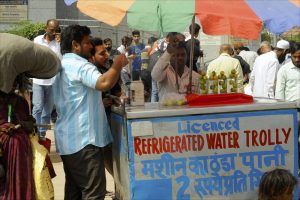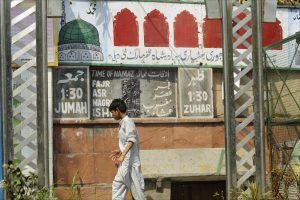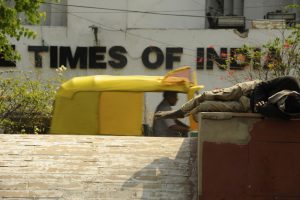Nonprofit Group Works to Raise Rare Disease Awareness in India
Written by |

Crowded Chandni Chowk market, also known as Delhi 6. India will soon overtake China as the world’s most populous nation, with 1.45 billion people. (Photo by Larry Luxner)
With an estimated 1.37 billion inhabitants, India will likely surpass China in five years as the world’s most populous country.
That also means it will have more rare-disease patients than any nation. It already has more than twice as many as the 28-member European Union.
Harsha K. Rajasimha, a genomics data scientist from Bangalore, is founder and director of the newly established Organization for Rare Diseases India (ORDI).
“We are a national umbrella organization representing the collective voice of over 70 million people with rare diseases in India,” Rajasimha said in a recent interview. “Our mission is to build collaborative bridges between the U.S. and India, and to connect them with patient advocacy groups, with research or clinical trials in the U.S., and with international consortia.”
Rajasimha was a speaker at the 2019 World Orphan Drug Congress USA, which took place April 10-12 at National Harbor in Oxon Hill, Maryland.
“There are multiple challenges, starting with lack of public awareness about rare diseases,” he said. “In second place is getting faster diagnosis of rare disease. Treatment comes at the very end, because 95% of rare diseases do not have any treatment. However, some are metabolic disorders that can be treated with diets and supplements.”
ORDI, which represents 25 to 30 patient groups in India, is also registered in the United States as a 501(c)(3) charity called ORDI USA. The charity was formed by Rajasimha and Prasanna Shirol, the father of a child with Pompe disease. ORDI USA is a member of the Connecticut-based National Organization for Rare Disorders (NORD).
As such, ORDI USA puts 70% of its efforts into helping U.S. patients connect with existing resources at the National Institutes of Health (NIH), the U.S. Food and Drug Administration, and nonprofits like NORD and Global Genes.
The remaining 30% goes toward enabling therapy access across borders and funding key initiatives in India, such as the country’s first 24/7 rare disease hotline — +91 8892 555000 — as well as community outreach programs, an assisted living facility for rare-disease patients, and an ambitious rare disease institute in New Delhi.
Rare disease policy in India
Rajasimha, 40, has been living in the Washington, D.C., area for the last 19 years. He studied at Virginia Tech, and has worked at NIH. He became active in the rare-disease field after losing a child to a congenital disorder in 2012.
“I was determined to apply my years of post-doctoral clinical research experience at NIH and industry experience to develop products and solutions to accelerate clinical research,” he said. “I got involved in patient advocacy and connected with numerous inspiring patients, parents, researchers, and philanthropists who had experienced better or worse.”
India has no standard definition of what constitutes a rare disease (in the United States, it is any disorder affecting fewer than 200,000 people; in the EU, it is a disease affecting fewer than 1 in 2,000).
Considering India’s huge population, ORDI suggests that a disease be defined as rare if it affects fewer than 1 in 5,000 people.
Earlier this month, ORDI sponsored the 7th International Conference on Rare & Undiagnosed Diseases: Addressing Patient Needs for Rare Disorders in India. The April 13-15 event took place in New Delhi.
Rajasimha said that in 2017, the Indian government announced a National Policy for Treatment of Rare Disorders, but “unceremoniously retracted” that policy the following year. ORDI is now appealing to India’s Supreme Court to reinstate the policy.
Meanwhile, it is also urging India’s state governments to implement their own policies on rare diseases, because many official healthcare decisions are made at the state, rather than national, level, as in the United States.
“There are thousands of rare diseases, but treatment is available for only some of them,” Shirol, the group’s co-founder, recently wrote in letters to the health secretaries, health ministers, chief secretaries, and chief ministers of all 29 of India’s states. “Treatment and supportive care are also beyond the means of most families. Given these issues, we need government support to promote early, accurate diagnosis and screening programs for rare diseases, including proper rehabilitation and counseling, which can make patients’ lives less painful.”
The ‘Race for 7’
Most Indians with rare diseases haven’t been diagnosed, Rajasimha said.
“They remain undiagnosed for long periods of time, so the first step is for all the people living with undiagnosed conditions to get a diagnosis so we know that what they have is a rare disease,” he said. “Once we know that, we can then look at whether there’s already a treatment available in the U.S. or Europe, and see if there are any ongoing clinical trials.”
ORDI operates on an annual budget of just under $1 million, though it needs at least $5 million a year to implement and sustain its various programs. To that end, its U.S. affiliate seeks $500,000 this year to establish an executive team to scale up fundraising and collaborations.
In February, ORDI sponsored the “Race for 7” — a 7,000-meter walk/run “awareness event” aimed at raising money for research on the estimated 7,000 known rare diseases. The race took place in Fremont, California; Frisco, Texas; Greenville, South Carolina, and Washington, D.C. The next “Race for 7” event takes place June 23 in Acton, Massachusetts.
In India, the race was staged in nine major cities: New Delhi, Thiruvananthapuram, Kochi, Mysuru, Coimbatore, Mumbai, Bangalore, Chennai and Kolkata.
The idea of spending huge amounts of money on patients with rare diseases may seem like a contradiction in India, where more than 500 million people lack access to toilets and basic sanitation. The widespread practice of defecation in fields and open spaces contaminates food and drinking water, leading to diarrhea and other common diseases.
“The cost of healthcare in India is low; 90% of people pay out-of-pocket, while only 10% are covered under health insurance programs,” Rajasimha said. Even open-heart surgeries cost only $10,000, which has led to an influx of so-called “medical tourists” to India — a country whose biggest health problems are diabetes, hypertension, AIDS and tuberculosis.
Lysosomal storage disorders such as Pompe disease and Gaucher disease are relatively more common in India than in Western countries. Duchenne muscular dystrophy and spinal muscular atrophy (SMA) are also seen throughout India, but available therapies for these conditions — whose costs are astronomical even by U.S. standards — are unattainable in India.
“Spinraza (nusinersen) for SMA has been approved but is very expensive. We are in the process of figuring out how we can help the SMA group in India gain access to Spinraza,” Rajasimha said, referring to the FDA-approved Biogen drug, which retails for $750,000 the first year and $375,000 each year after. “But it would have to be priced accordingly. The pharmaceutical companies would gain three times as many patients than in the U.S. or Europe, so if they can provide it at one-third the cost, it would be a win-win.”










